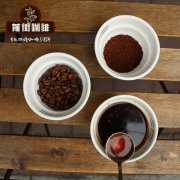Indian monsoon coffee | the history of wind-stained Malaba coffee? How to brew wind-stained coffee? Indian.

Professional coffee knowledge exchange more coffee bean information please follow the coffee workshop (Wechat official account cafe_style)
Indian monsoon coffee | History of wind-stained coffee? How to brew wind-stained coffee? Is the Indian wind-stained coffee good?
When it comes to Asian coffee, Taiwanese consumers should be most familiar with low-acid, mellow Sumatran coffee, or Vietnamese coffee, which has been increasing in production in recent years, but in fact, Indian coffee is the ancestor of the Asian region. As early as the 17th century, India was already an important supplier of coffee to Europe in addition to the Yemeni port of Moka. At that time, most of the Indian coffee beans were shipped by sail to the European continent on a voyage of about six months. During the voyage for more than half a year, due to the blowing of the sea breeze and absorbing the moisture and salty smell from the cabin, the coffee beans changed in appearance and taste. The appearance of raw beans will gradually change from dark green to yellowish brown like rice, and the beans will swell and enlarge.
The acidity of the coffee is smoothed out in the process and replaced by the development of flavors such as nuts, caramel and tea (this ripe taste shift is also a bit similar to Sumatran beans), as well as a thick taste. Indian style soy beans do have their own unique flavor, and I like it quite much. It usually tastes sweet with nuts and grains, almost sour, and often with the aroma of Xuanmi tea. It is said that Nordic people liked this special golden coffee very much at that time.
Coffee traders who are proficient in business certainly feel the demand of consumers in the market. Interestingly, when the Suez Canal opened in 1869, coupled with the advent of steamships, the time from India to Europe was greatly shortened, which was supposed to be much more profitable for businessmen to sell Indian coffee. Unexpectedly, European customers complained that the coffee was stale, resulting in a sharp drop in orders.
In the early days, the speed of maritime transportation was slow. During the long shipping to Europe, coffee beans from India were blown by the moist sea breeze, which led to interesting changes in the flavor and appearance of beans, from green to golden, the taste became mellow and very low acidity, and developed a strong nutty and shell flavor. now with the progress of science and technology, the special flavor of this raw bean can be reproduced manually, collecting selected AA raw beans. During the monsoon season, the raw bean is exposed to the air, and then in a continuous turning way, the raw bean is fully exposed to the moist sea breeze, and then carefully selected artificially, so its special flavor is reborn.
The wind-stained coffee needs to be made with sun-dried beans, and the factory faces to the west in order to catch the salty monsoon blowing from the southwest.
The windows of the wind-soaked field of coffee beans are all open, and the wind stains will enter the bag to a certain extent, the raw beans can not be filled, the coffee bags should not be piled too dense to avoid mildew, and the coffee beans should be poured out from time to time to replace the linen bags to avoid mildew.
The weathering period is about 12 to 16 weeks. After it is ripe, it is fumigated to drive away the weevil. Finally, the beans are screened manually to pick out the failed beans that have not turned golden. After three to four months of wind stains, the volume of green coffee beans increased by one to two times, the weight and density decreased, the moisture content was about 13%, and the quality and quantity changed significantly.
Flavor characteristics:
Indian Malaba coffee beans are soft beans that are strong and dry outside. There is a ripe mellow flavor peculiar to "aged Sumatra mantenin". The taste of Xuanmi tea is very special, with a light balance of grass, acidity and bitterness. it is also suitable for blending comprehensive coffee beans.
Wind-stained coffee needs to be made with sun beans, and all factories dealing with wind-stained coffee face to the west to meet the salty and wet monsoon blowing from the southwest sea. The coffee beans are spread flat in the wind field, the windows are all open, and the wind stains to a certain extent, and then enter the bag, but because the beans will expand a lot in the process, the coffee beans can not be filled too full, and the coffee bags should not be piled too dense to avoid mildew and spoilage due to lack of wind. It is also necessary to pour out coffee beans and replace sacks from time to time to avoid mold, which is a very time-consuming and labor-consuming project. The weathering period is about 12 to 16 weeks, and after it is ripe, it will be fumigated to drive out the weevil, and finally the beans will be screened manually to remove the failed beans that have not turned golden. After three to four months of wind treatment, green coffee beans are twice as large in volume and reduced in weight and density.
Although the wind-stained Malabar coffee beans seem to be big and fat, they are soft beans that are strong and dry outside, a change that has taken place after months of weathering. Coffee beans have been exposed to the moist monsoon for several weeks, which not only turns the beans yellow, but also reduces the acidity of the coffee itself, and the taste is very special. In addition to serving as a single product, Indian Malabar coffee beans are also suitable for blending integrated coffee beans.
Qianjie recommended cooking:
Filter cup: Hario V60
Water temperature: 88 degrees
Degree of grinding: small Fuji degree of grinding 4
Cooking methods: the ratio of water to powder is 1:15, 15g powder, the first injection of 25g water, 25 s steaming, the second injection to 120g water cut off, waiting for the powder bed water to half and then water injection, slow water injection until 225g water, extraction time about 2:00
Analysis: using three-stage brewing to clarify the flavor of the front, middle and back of the coffee. Because the V60 has many ribs and the drainage speed is fast, it can prolong the extraction time when the water is cut off.
Important Notice :
前街咖啡 FrontStreet Coffee has moved to new addredd:
FrontStreet Coffee Address: 315,Donghua East Road,GuangZhou
Tel:020 38364473
- Prev

Introduction to 90 / 90 + Coffee beans | [Ruby treatment] [sk treatment] [Maker Series
Professional coffee knowledge exchange more coffee bean information please follow the coffee workshop (Wechat official account cafe_style) 90 / 90 + coffee bean introduction | what is [Ruby treatment] [sk treatment] [Maker Series treatment]? How to grade 90 + beans? In the process of handling raw beans, 90+ has also added many new concepts to make the performance of coffee beans more acceptable and powerful.
- Next

Is there any coffee in India? How did Indian style-stained Malaba coffee beans come from? Unique wind stain treatment method
Professional coffee knowledge exchange more coffee bean information please follow the coffee workshop (Wechat official account cafe_style) is there coffee in India? How did Indian style-stained Malaba coffee beans come from? What is the unique wind stain treatment method? Monsoon coffee is also a famous coffee in India. Coffee is placed in an open warehouse by the sea, which is hit by the monsoon, which makes the volume of coffee expand and
Related
- Detailed explanation of Jadeite planting Land in Panamanian Jadeite Manor introduction to the grading system of Jadeite competitive bidding, Red bid, Green bid and Rose Summer
- Story of Coffee planting in Brenka region of Costa Rica Stonehenge Manor anaerobic heavy honey treatment of flavor mouth
- What's on the barrel of Blue Mountain Coffee beans?
- Can American coffee also pull flowers? How to use hot American style to pull out a good-looking pattern?
- Can you make a cold extract with coffee beans? What is the right proportion for cold-extracted coffee formula?
- Indonesian PWN Gold Mandrine Coffee Origin Features Flavor How to Chong? Mandolin coffee is American.
- A brief introduction to the flavor characteristics of Brazilian yellow bourbon coffee beans
- What is the effect of different water quality on the flavor of cold-extracted coffee? What kind of water is best for brewing coffee?
- Why do you think of Rose Summer whenever you mention Panamanian coffee?
- Introduction to the characteristics of authentic blue mountain coffee bean producing areas? What is the CIB Coffee Authority in Jamaica?

